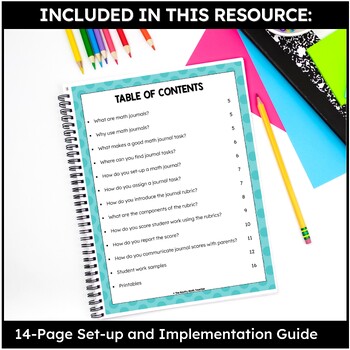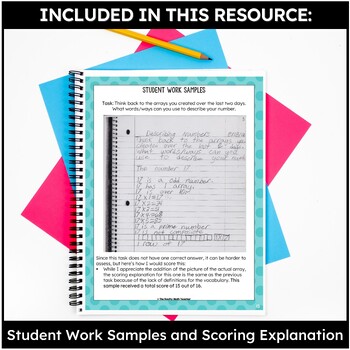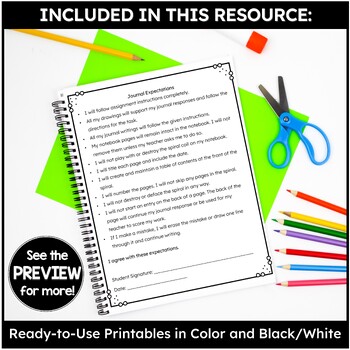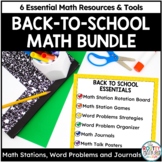Math Journals Resource Guide: Math Journal Cover, Rubric, and Printables
- Zip
What educators are saying
Also included in
- Are you looking for all the things you need to get your math classroom ready for back to school? This bundle includes back-to-school math essentials for every classroom including math bulletin boards, a math station rotation board, math board game templates, strategies for solving math word problemsPrice $18.83Original Price $26.90Save $8.07
Description
Are you ready to increase your students’ written communication and critical thinking skills with math journals?
This resource is designed for teachers who want to use math journals in the classroom. This pack includes a math journal rubric that can be used to evaluate your students’ work, three math journal templates, and a 14-page resource guide with student work samples— everything you need to implement math journals in your classroom tomorrow.
What’s unique about this resource?
❤️ The math journal rubric includes student-friendly language and is designed to help students analyze their work for areas of improvement.
❤️ The 16-page resource and implementation guide provides all the details needed to get started with math journals.
❤️ Student samples and scoring explanations are included to help teachers understand the scoring process.
❤️ The ready-to-use templates and printables are included to help you get started with math journals right away.
What’s included in this resource?
This 14-page resource guide includes the following topics:
✅ What are math journals
✅ Why use math journals
✅ What makes a good math journal task
✅ Where to find journal tasks
✅ How to set up math journals
✅How to assign a journal task
✅ Introducing the journal rubric
✅ Components of the rubric
✅ Scoring the rubric
✅ Reporting the score
✅ Communicating with parents
✅ Student writing samples
The following math journal templates are also included:
✅ Student-friendly Rubric
✅ Journal cover (two versions available in color and black and white)- NEW
✅ Student expectations (editable)- NEW
✅ Table of contents (two versions)
✅ Grading tools, including labels and quarter-sized rubrics
✅ Math Journal Labels (two versions that coordinate with the covers)- NEW
▶️ Want ready-made math journal prompts? Check out these resources!
Digital Math Activities for Google Classroom Bundle
Teachers Like You Said . . .
⭐️⭐️⭐️⭐️⭐️ I have been wanting a great way to assess students with their math journals, and really have them use it as a tool. Thank you for this awesome resource! ~ Misty N.
I hope this pack helps to increase your students’ communication and critical thinking skills!- The Routty Math Teacher
Keep up with The Routty Math Teacher!
Be the first to learn about doing math The Routty Way. I will send information about new blog posts, free resources, and new product information. Sound interesting? Become a follower of The Routty Math Teacher by clicking here or on the green star on any of my product pages and receive email updates in your TPT inbox.
Leave feedback and receive TPT credit!
Did you know you can build TPT credit by leaving feedback on our products?
You can submit feedback at the time of purchase or go to “My Purchases” for a list of what you have bought in the past. Next to each title is a “Leave Feedback” button. Click it and leave a rating and comment to receive the credit. Go to TPT Credits to learn how to redeem your credits on future purchases!
Like this pack? Share it with others!
Use the share buttons so others will find it! Just click the Facebook, Twitter, or Pinterest button to share it with others!
Terms of Use: This product is copyrighted by Shametria Routt Banks. All rights reserved. Purchase of this product entitles the purchaser the right to reproduce the pages in limited quantities for classroom use only. Duplication for an entire school, an entire school system, or commercial purpose is strictly forbidden without written consent from the publisher. For questions, please contact Shametria@therouttymathteacher.com






